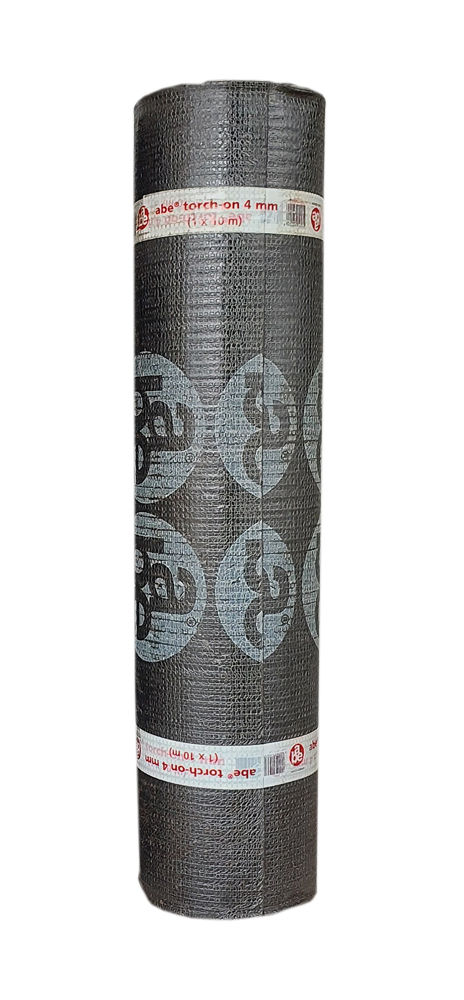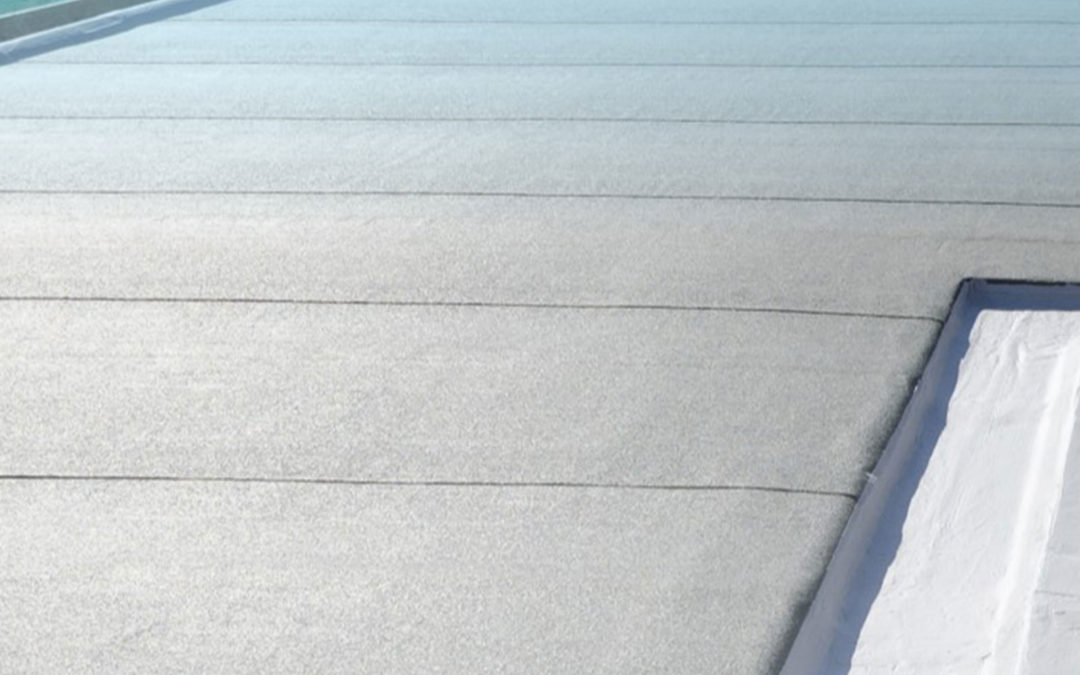Waterproofing torch-on membrane
The abe.®torch-on 4 mm membrane manufacturing processes uses polymer modified bitumen reinforced with a composite reinforcement. This ensures a good quality membrane that has high elongation and stability across the defined temperature range. Ideal for use in warmer climates. The upper face of abe.®torch-on 4 mm membrane are coated with a uniformly distributed, fine serigraphed talc, a patented treatment which allows the membrane to be unrolled easily during the application.
The underside of the membrane is lined with Flamina, a sacrificial polyethylene film. It is embossed with small squares which assist in the rapid burn-off of the Flamina indicating the correct melting point for adhesion to a substrate ensuring a reliable installation.

Uses
- abe.®torch-on 4 mm can be used as a single layer system or as part of a multi-layer in both the refurbishment and new building works market.
- On all sloping surfaces: flat, vertical and curved
- On different types of substrates: site-cast or pre-fabricated concrete substrates, on timber roofing and on the most common thermal insulation used in the building trade
Advantages
- Long life expectancy
- High elongation strength
- Guaranteed water tight
- Recycable
- Stable
- Shear resistance of joints
- Resistance to teading
- Puncture resistant
Bonding / Priming
All cementitious surfaces must be primed with abe®bitu.®prime at a rate of approximately 3.5m2/L. Depending on the of the surface a second coat of primer may be required.
Application
The most popular installation method is by torch fusion using a suitable propane gas torch. The membrane needs to be fully bonded by heat fusion to the bitu.®prime primed surface. The surface needs to be sound clean and dry having no sharp protrusions, providing a surface texture compared with at least a fine wood float finish. The cast concrete surface must be allowed to dry before the sheet is applied. Drying depends on the weather and may take from 8 days to 3 weeks. To protect timber floors from the flame, either sheets of ROLLBASE or abe®malthoid 5-ply must be nailed before application of the membrane.
A suitable screed offering adequate falls, a minimum of 1:80, is to be provided to lead the water off to the drainage outlets. To bond the sheet to the substrate and on the overlaps, use the torch flame to melt the flaming lining on the lower face of the membrane while the membrane is being unrolled. During installation ensure that the side and end laps are 100 mm and 150 mm respectively. When two layers are applied abe® torch-on installation should be fully torched to the first layer by heat fusion.
The membrane must be laid in a centrally staggered manner with the side and end laps. Ensure that the laps and the membrane are not over heated.
Coverage
Effective coverage: 8,9m²/roll.
Cleaning
Tools, brushes and mixing equipment should be cleaned immediately after use and before material has set with abe® super brush cleaner followed by washing with soap and water.
Protection On Completion
Wherever abe.®dur S is being laid, every effort must be made to prevent too rapid drying of the screed. Draughts should be excluded and direct sunlight must be avoided. To be able to perform as designed, abe.®dur S screeds must be fully cured. The preferred method of curing is to pond the surface as soon as it will bear traffic and then to cover with polythene sheets weighed down with sand-filled polythene sausages. A spray-applied a.b.e.® approved concrete curing compound may be used where a polythene sheet is impracticable (dura.®cure SBC or Chryso Cure WB). Curing should be continued for at least five days.
Preferably after 2 to 3 months after completion apply two coats of abe.® silvakote to the surface to improve the resistance against UV rays or as recommended by a.b.e.® Construction Chemicals.
Technical Characteristics
| Weight (EN 1849-1) | ±10% | 4 kg/m2 |
| Roll size (EN 1848-1) | ≥ | 1 × 10 m |
| Reinforcement | ‘Non-woven’ composite polyester fibreglass stabilised with fibreglass | |
| Watertightness (EN 1928 – B method) | ≥ | 60 kPa |
| After ageing (EN 1296-1928) | ≥ | 60 kPa |
| Shear resistance (EN12317-1) | -20% | 350/250 N/50 mm |
| Maximum tensile force Long./Trasv. (EN 12311-1) | -20% | 400/300 N/50 mm |
| Elongation (EN 12311-1) | -15 V.A. | 40/40% |
| Resistance to impact (EN 12691 – A method) | 700 mm | |
| Resistance to static loading (EN 12730) | 10 kg | |
| Resistance to tearing (nail shank) (EN 12310-1) | -30% | 120/120 N |
| Resistance to tearing (nail shank) (EN 12310-1) | ≤ | 0 °C |
| Flow resistance at elevated temperature (EN 1110) | ≤ | 100 °C |
| Reaction to fire class (EN 13501-1) | Euroclass F |
Packaging
Supplied in rolls of 10m x 1m.
Caution
This is not a do-it-yourself product, consult an experienced contractor.
Health and Safety
Product safety information required for safe use is not included. Before handling, read product and safety data sheets and container labels for safe use, physical and health hazard information. The safety data sheet is available from your local a.b.e.® Construction Chemicals branch.
Important Note
This data sheet is issued as a guide to the use of the product(s) concerned. Whilst a.b.e.® Construction Chemicals endeavors to ensure that any advice, recommendation, specification or information is accurate and correct, the company cannot – because a.b.e.® has no direct or continuous control over where and how a.b.e.® products are applied – accept any liability either directly or indirectly arising from the use of a.b.e.® products, whether or not in accordance with any advice, specification, recommendation, or information given by the company.
Further Information
Where other products are to be used in conjunction with this material, the relevant technical data sheets should be consulted to determine total requirements. a.b.e.® Construction Chemicals has a wealth of technical and practical experience built up over years in the company’s pursuit of excellence in building and construction technology.

